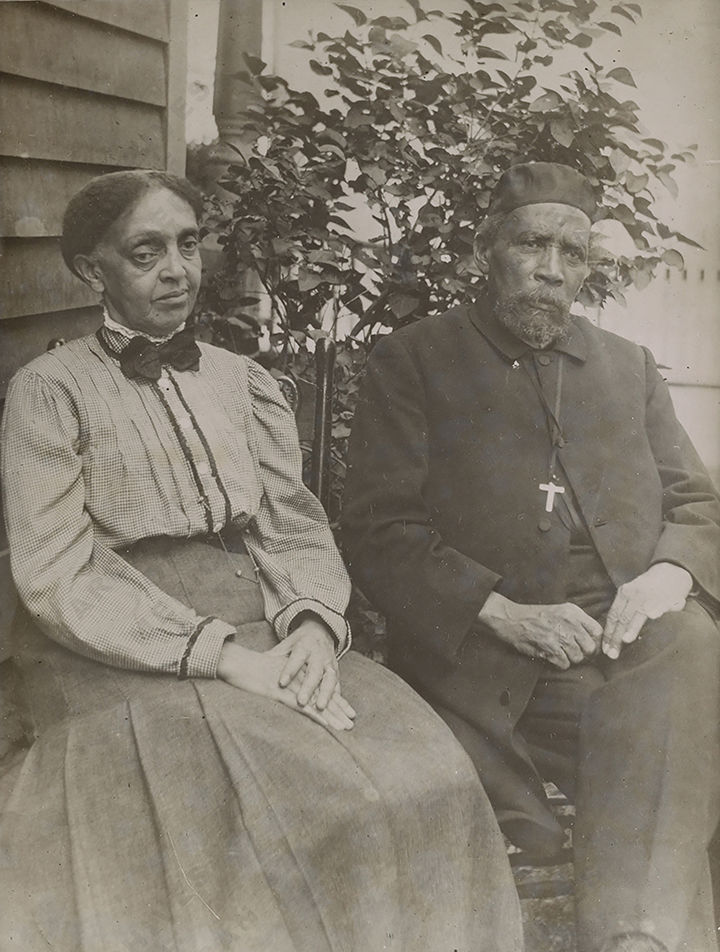In late January 2018, a portrait bust of an esteemed American artist was relocated from the Henry R. Luce Center into the second-floor gallery 766 of the American Wing, where it's now displayed alongside a painting by its sitter. At the time Charles Grafly modeled his bust of Henry Ossawa Tanner in 1896, the latter artist was in the middle of a transformative period. Tanner, an African American expatriate who moved to France in part because of the United States's racial intolerance, had just completed Daniel in the Lions' Den. The painting marked the artist's pivot to the biblical scenes that would serve as his subjects for the next 40 years, until his death in 1937.

Tanner's parents, Sarah Miller Tanner and Bishop Benjamin Tucker Tanner, ca. 1900. Henry Ossawa Tanner Papers, 1860s–1978, bulk 1890–1937. Archives of American Art, Smithsonian Institution. Public domain image via Wikimedia Commons
In such religious pictures, Tanner—whose mother escaped slavery through the Underground Railroad, and whose father was a bishop in the politically active African Methodist Episcopal (AME) Church—found license to synthesize many of the motifs he had elsewhere explored. As Dewey F. Mosby wrote on the occasion of a 1991 Tanner retrospective, "issues of social justice must have been on Tanner's mind. … Informed by his family background and his desire to represent profound issues of black life, Tanner now looked to the Bible for some of his most vital themes … : slavery, false accusations, execution, and martyrdom."[1]
Both Daniel in the Lions' Den and Grafly's bust of the painter were submitted to the 1896 Salon in Paris, but only one was accepted.[2] Tanner's painting was exhibited and it received a coveted award. "True it was but a 'mention honorable,'" he wrote, "but it was an 'honor.'" Grafly's portrait, though, was rejected for the official reason that it appeared too realistic, too true to life.
"That reason is an old saw," Thayer Tolles, Marica F. Vilcek Curator of American Paintings and Sculpture, told me. Similar critiques were leveled at Auguste Rodin for The Age of Bronze, which critics doubted could have been sculpted in such detail by hand. But whatever the reason for its rejection at the Salon, Grafly's portrait found a home in Tanner's Paris studio, when it was gifted that year to the painter in recognition of the friendship shared by the two artists. They had both studied under Thomas Eakins at the Pennsylvania Academy of the Fine Arts, and at the Académie Julian, a progressive alternative to the École des Beaux-Arts in Paris.
Charles Grafly (American, 1862–1929). Henry O. Tanner, 1896. Painted plaster, 28 x 12 x 9 3/4 in. (71.1 x 30.5 x 24.8 cm). The Metropolitan Museum of Art, New York, Gift of J. O. Tanner, 1949 (49.54)
Though modeled in plaster—often an intermediary medium for artists who work in marble or bronze—the fact that the bust is painted to resemble patinated bronze suggests that the sculpture was intended as a finished product. Typical of Beaux-Arts design, Grafly's treatment of his subject is naturalistic rather than idealized, with an emphasis on texture and the play of light over the surface. The sculptor suggests a confident though unimposing presence in the painter, whose shoulder and head are turned in contemplation. Today, Grafly is recognized as much as an educator as a sculptor. His portrait busts, including 14 of artists with whom he was friends, are among his most celebrated works.
Similarly, Tanner found that religious parables, informed by black consciousness, also presented opportunities for formal experimentation. "The majority of Tanner's biblical themes … are easily linked to messages of human rights and social justice," Mosby notes, though in a way that's inextricable from their stylistic treatment. In the first version of Flight into Egypt (1899),
the lack of articulation in the faces and figures and the unemphasized Christ Child, who is seen only as a bundle of cloth on Mary's lap, allows one to see them as ordinary people drawn from the crowds that hurried toward Bethlehem. The biblical figures become timeless travelers, whose anxious journey gives them a universality that extends even to the African American migrants of Tanner's time.
Henry Ossawa Tanner (American, 1859–1937). Flight into Egypt, 1923. Oil on canvas, 29 x 26 in. (73.7 x 66 cm). The Metropolitan Museum of Art, New York, Purchase, Marguerite and Frank A. Cosgrove Jr. Fund, 2001 (2001.402a)
The version of Flight into Egypt in The Met collection was completed in 1923, which Sylvia Yount, Lawrence A. Fleischman Curator in Charge of the American Wing, identifies as Tanner's mature period—conventional in its narrative and thematic structures, but experimental in execution. The painting's varnish is mixed with wax and the surface is tactile and intricately glazed, techniques that art historians have associated with modernism.[3]
In both Grafly's portrait and Tanner's Flight into Egypt, formal innovation is rooted in the artists' personal views of the world and their respective subjects. Seeing the works together allows us to recognize the talents of two creative individuals approaching time-honored genres—portraiture and history painting—with innovation and sensitivity.
Notes
[1] Unless specified, all quotes from Dewey F. Mosby, Henry Ossawa Tanner (Philadelphia: Philadelphia Museum of Art, 1991). Return
[2] In 1904, Booker T. Washington secured patrons in an effort to place the painting in The Met. The painting, for which Tanner requested $3,000, was never sold, and its location is unknown today (a later version is owned by the Los Angeles County Museum of Art). See Mosby 154. Return
[3] See Henry Ossawa Tanner: Modern Spirit, edited by Anna O. Marley (Berkeley and Los Angeles, California: University of California Press, 2012). Return
Henry Ossawa Tanner's Flight into Egypt and Charles Grafly's Henry O. Tanner are on view in gallery 766 of the American Wing.
Marquee: Installation view of Henry Ossawa Tanner's Flight into Egypt and Charles Grafly's Henry O. Tanner in gallery 766 of the American Wing



















